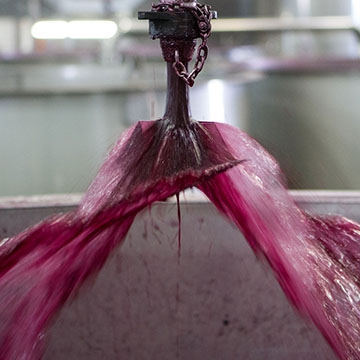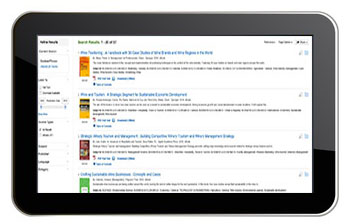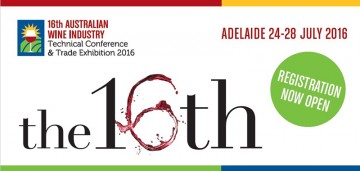The power of oxygen during fermentation
Is your winery water creating musty wines?
Vineyards and wineries contributing to decreasing greenhouse gas emissions
International alcohol policy changes
Events coming up after vintage
Revised version of the Food Standards Code
Order the latest AWRI staff publications online
Investigation of grape and wine production practices |
|
 |
Recently published AWRI research has shown that the formation of reductive aroma compounds (such as hydrogen sulfide, methanethiol, ethanethiol and their corresponding thioacetates) is significantly affected by treating wines with O2 in the early stages of fermentation. In fact, the formation of some of these compounds in a Shiraz wine was completely eliminated through careful O2 dosage early in fermentation. These wines showed desirable red and dark fruit aromas when assessed by a sensory panel.
Commonly used remediation treatments were also assessed for their effectiveness in removing ‘reductive aromas’ from wines that had been treated reductively. Early copper fining was the most effective treatment; however, none of the treatments were able to produce wines with sensory profiles similar to wines treated oxidatively during fermentation. The full paper detailing these results is accessible via the AWRI library: Bekker, M.Z., Day, M.P., Holt, H., Wilkes, E., Smith, P.A. 2016. Effect of oxygen exposure during fermentation on volatile sulfur compounds in Shiraz wine and a comparison of strategies for remediation of reductive character. Aust. J. Grape Wine Research 22(1): 24–35. |
Is your winery water creating musty wines? |
|
| In the past six months the AWRI helpdesk has investigated a number of cases of ‘musty’/‘TCA-like’ characters in wine. Interestingly, a large percentage of these investigations have identified water as the source of contamination. Tests of winery water supplies have confirmed the presence of TCA (2,4,6-trichloroanisole), which is an extremely potent ‘musty’ aroma compound, perceptible in wine at parts per trillion levels. However, it hasn’t been possible to identify the source of the TCA in the water. In one investigation, a number of wines became contaminated after musty water was used to rinse a cross flow filter.
This is not the first time the helpdesk has seen contamination of wines from musty water. To decrease the risk of this type of contamination, the helpdesk team advises that water used in the winery should be assessed routinely to ensure musty characters are not present. People vary in their sensitivity to musty taints, so it may be important to use more than one person to assess water samples regularly and to conduct the assessments in an environment that doesn’t have background musty aromas. For assistance in dealing with contamination problems, please contact the AWRI helpdesk on 08 8313 6600 or helpdesk@awri.com.au. TCA analysis of wine and water samples is available from AWRI Commercial Services. |
|
App updates |
|
| The AWRI supports two free apps for Australian grapegrowers and winemakers – The AWRI Agrochemical Search app and the AWRI Winemaking Calculators app.
The Agrochemicals app allows growers to quickly identify agrochemicals for use in the production of grapes for export wine and comply with any restrictions on their use. The Winemaking Calculators app provides a single access point for a wide range of important wine-related calculations – including fining rates, acid or SO2 additions, conversions and standard drinks calculations. Both apps are available for Apple and Android platforms, with a recent update ensuring compatibility with Android 5.0. If Android users have experienced any issues with either app in the past, it is recommended to delete the apps and re-install them from Google Play to ensure access to the latest version. For assistance with either app, please contact the AWRI helpdesk. |
|
Vineyards and wineries contributing to decreasing greenhouse gas emissionsLate last year, an ambitious deal was struck by international leaders at the Paris Climate Conference, with an agreement signed by 197 countries. This agreement stated that greenhouse gas (GHG) emissions should peak “as soon as possible,” followed by rapid reductions and a five-year cycle for reviewing emissions cuts with action to be continually ratcheted up. Australia’s commitment is to reduce GHG emissions by 26 to 28 per cent below 2005 levels by 2030 primarily through the Emissions Reduction Fund, a government-financed fund which purchases emission reductions credits, and the Renewable Energy Target of 23% renewables by 2020. The AWRI provides an online tool to assist grape and wine businesses to measure and benchmark GHG emissions. In 2014/15 for the first time, vineyards and wineries reported their use of on farm and business generated renewable electricity through Entwine Australia. The results showed 11% of Entwine members were generating renewable energy. Small wineries (500-2000 tonnes) had the highest uptake of renewable energy generation, reporting an average of 30% of their electricity needs being supplied by renewables. Vineyards reported significantly higher proportions of their electricity needs being supplied by renewables. Of the 43 vineyards using renewable energy, 15% generated more than 100% of their requirements with some reporting electricity generation 3 to 35 times the amount required in the vineyard. Those vineyards generating less than 100% of their electricity averaged around one-third of their total electricity requirements. Australian wine-grape growers and winemakers can access the new Australian Wine Carbon Calculator and benchmarking tool by becoming members of Entwine Australia. For more information, please visit the Entwine Australia page on the AWRI website or contact the AWRI helpdesk helpdesk@awri.com.au or by telephone 08 8313 6600. |
|
International alcohol policy changesTwo countries (the UK and Malaysia) are currently proposing changes to aspects of their public health policy on alcohol. These changes are consistent with the World Health Organization’s recently recommended strategies to reduce alcohol-related harms, especially in vulnerable or ‘at high risk’ population groups such as youth and young adults. The changes are relevant to Australia because they could be taken into consideration when the Australian drinking guidelines are reviewed later this year. On 1 December 2015, Malaysia notified the World Trade Organisation (WTO) that it plans to raise the minimum age for legal alcohol consumption from 18 to 21 years. This forms part of a strategy that aims to limit the accessibility of alcohol to high risk groups. The majority of countries have a minimum age of 18 years for legal alcohol consumption. The UK government has opened a public consultation on proposals to change its alcohol drinking guidelines. The main proposed changes are that both men and women should not consume more than 14 UK (8 g) units of alcohol per week. Compared to the current guidelines, this is a reduction in amount and a change from a daily to a weekly limit. The current guidelines suggest that men should not regularly consume more than 3-4 UK units per day and women 2-3 UK units per day. More information about the proposed change is available from this website. |
|
What’s new in eBooks? |
|
 |
Seven new eBooks have recently been added to the AWRI’s collection, with topics covering the US and Chinese wine industries, vineyard soils, winery tourism and climate change.
To keep in touch with the eBooks collection and access the latest books, visit the new eBook titles page on the AWRI website. Not sure how to go about reading an eBook? Check out this this webinar or contact the AWRI information services team (infoservices@awri.com.au ). |
16th AWITC deadlines in April |
|
 |
While July might still seem a long way away, there are some key AWITC deadlines coming up soon. Both early bird registrations and poster abstract submissions close on 15 April 2016. A detailed program is now available, with just a few final speakers to confirm. Register now to lock in early bird prices and secure your preferred workshop places. Discounted tickets to the Maurice O’Shea Award Dinner are available to AWITC delegates and can be purchased as part of your registration.
The poster display is an essential element of every AWITC and a great opportunity to present the latest research outcomes to a large industry audience. Poster authors are eligible to win a prize or to be selected to present in one of the ‘Fresh Science’ sessions. Submit your abstract online before 15 April or contact Dr Eveline Bartowsky, Poster Coordinator, at posters@awitc.com.au if you have any questions. For any other conference-related queries, please contact Kate Beames, Conference Manager on 08 8313 6821 or kate.beames@awitc.com.au. |
Events coming up after vintageThe AWRI’s extension activities (seminars, workshops and webinars) take a break during vintage, but will be ramping back up from mid-April. In the webinar program, topics coming up include cover crops, managing oxygen during winemaking, redirecting rain to manage salinity and the effects of closures on shelf life. Three trunk disease management workshops will be presented in Victoria in late April, and three sustainability workshops will be held in May in Mt Barker (WA), McLaren Vale and Orange. The next roadshow seminar will be in Coonawarra on 31 May and two ‘Adapting to Difficult Vintages’ workshops will be presented in Rutherglen and Goulburn Valley in late June. For details on all of these events, visit the AWRI events calendar, contact your local association or email the events team at the AWRI. |
|
Revised version of the Food Standards CodeA revised version of the Australia New Zealand Food Standards Code came into effect on 1 March 2016. This Code houses winemaking regulations related to additive and processing aid permissions as well as maximum agrochemical limits, other residue information and some labelling specifications. The Code had been revised so it more closely aligns with Food Acts in Australian states and territories and in New Zealand, but while it looks very different, the changes are relatively minor in nature. A summary of the changes and the new version of the Code are available online. |
|
Order the latest AWRI staff publications onlineAccessing the latest AWRI publications is easy. Visit the AWRI Publications web page to:
A full list of AWRI publications published since the last eNews is included below. 1790 Geffroy, O., Yobrégat, O., Dufourcq, T., Siebert, T., Serrano, E. Certified clone and powdery mildew impact Rotundone in red wine from Vitis vinifera L. cv. Duras N. J. Int. Sci. Vigne Vin 49 (4): 231-240; 2015. 1791 Longbottom, M. ASVO announces new board line-up and Fellow, bolsters industry collaboration. Wine Vitic. J. 31 (1): 10; 2016. 1792 Abbott, T., Longbottom, M., Wilkes, E., Johnson, D. Assessing the environmental credentials of Australian wine. Wine Vitic. J. 31 (1): 35-37; 2016. 1793 Dry, P. Graciano. Wine Vitic. J. 31 (1): p. 57; 2016. 1794 Gawel, R., Schulkin, A., Day, M., Barker, A., Smith, P.A. Interactions between phenolics, alcohol and acidity in determining the mouthfeel and bitterness of white wine. Wine Vitic. J. 31 (1): 30-34; 2016. 1795 Kilmister, R., Unwin, D., Treeby, M., Edwards, E., Krstic, M. Effect of elevated CO2 and temperature on phenology, carbohydrates, yield and grape composition – preliminary results. Wine Vitic. J. 31 (1): 38-40, 42; 2016. 1796 Borneman, A.R., Forgan, A.H., Kolouchova, R., Fraser, J.A., Schmidt, S.A. Whole genome comparison reveals high levels of inbreeding and strain redundancy across the spectrum of commercial wine strains of Saccharomyces cerevisiae. G3 DOI:10.1534/g3.115.025692; 2016. 1797 Lockshin, L., Corsi, A.M., Cohen, J., Lee, R., Williamson, P. West versus East: measuring the development of Chinese wine preferences. Food Qual. Pref. DOI: 10.1016/j.foodqual.2016.02.014; 2016. 1798 Wang, J., Capone, D.L., Wilkinson, K., Jeffery, D.W. Rosé wine volatile composition and the preferences of Chinese wine professionals. Food Chem. 202: 507-517; 2016. 1799 McRae, J.M., Bindon, K.A., Hixson, J.L., Smith, P.A. Wine tannin structure and extraction: Review of current research. Combs, C.A. (ed.) Tannins: Biochemistry, food sources and nutritional properties. New York, USA: Nova Science Publishers: 85-120; 2016. 1800 Stockley, C.S. A review of the relationship between wine consumption and type 2 diabetes mellitus. J. Nutr. Therapeut. 4(4): 124-134; 2015. 1801 Cavallaro, A., Mierczynska, A., Barton, M., Majewski, P., Vasilev, K. Influence of immobilized quaternary ammonium group surface density on antimicrobial efficacy and cytotoxicity. Biofouling 32(1): 13-24; 2016. 1802 Petrie, P. Ask the AWRI: Measuring canopy size. Aust. N.Z. Grapegrower Winemaker (625): 36-37; 2016. 1803 Zhang, P., Fuentes, S., Siebert, T., Krstic, M., Herderich, M., Barlow, E.W.R., Howell, K. Terpene evolution during the development of Vitis vinifera L. cv. Shiraz grapes. Food Chem. DOI: 10.1016/j.foodchem.2016.02.125; 2016. 1804 Stockley, C.S. Wine consumption, cognitive function and dementias – A relationship? Nutr. Aging 3 (2-4): 125-127; 2015. 1805 Stockley, C.S. Role of wine components in inflammation and chronic diseases. Moreno-Arribas, M.V., Sualdea, B.B. (eds.) Wine safety, consumer preference and human health. Cham, Switzerland: Springer: 241-258; 2016. |
|
AcknowledgementThe AWRI acknowledges support from Australia’s grapegrowers and winemakers through their investment body, Wine Australia, with matching funds from the Australian Government. The AWRI is a member of the Wine Innovation Cluster in Adelaide, South Australia. ‘The power of oxygen during fermentation’ image is courtesy of Eric Wilkes. |
|

